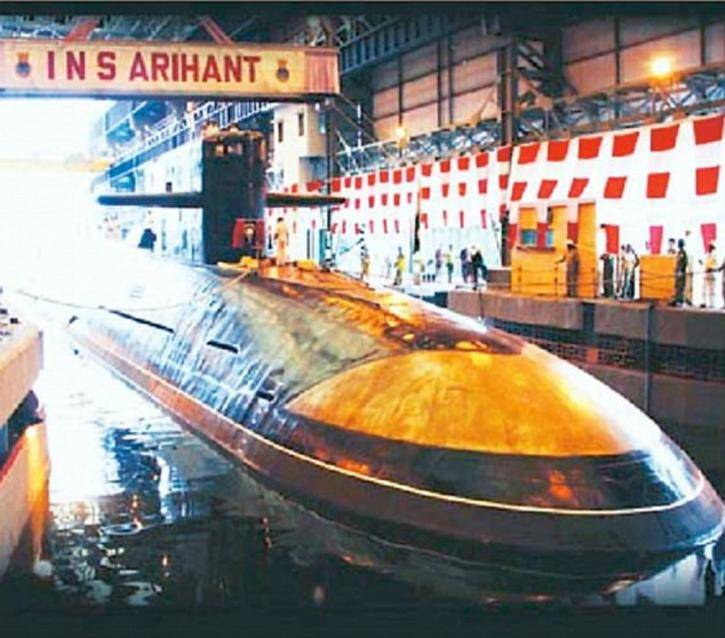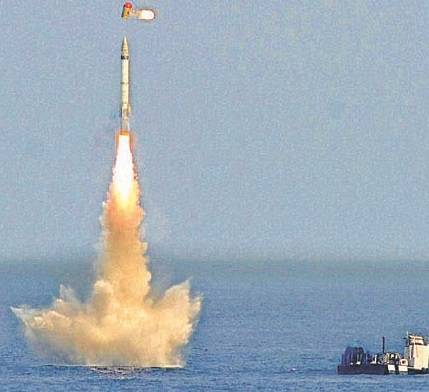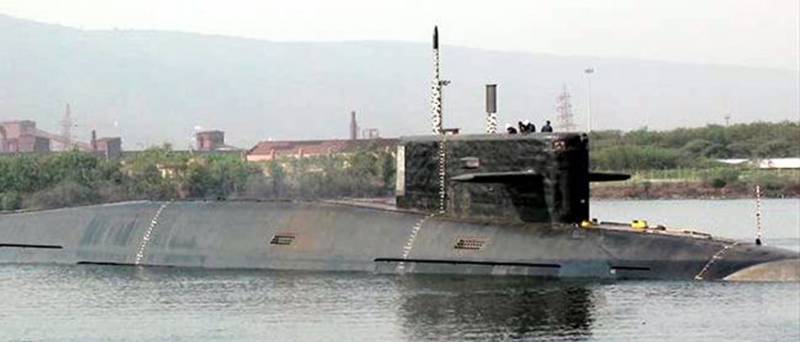Indian nuclear triad. Underwater component
It seems that in this statement a great deal is desired for real. There is a certain triad in India, but what? Certainly not strategic.
So what is the position of India in the nuclear missile plan? Let's start with the marine components. It is necessary to begin, obviously, with the Arikhant SSBN itself and its origin.
Following Modi’s statement, articles followed in the Indian press on how important this event (the first SSBN combat service) is for a country that pledged not to use nuclear weapons. weapons first, and how it will be analyzed by analysts and the military "all over the world" (!). I am sure that in both nuclear superpowers in the upper headquarters they did not particularly pay attention to this epoch-making event. And in general, they say, according to the authors of such publications, SSBN "Arikhant" is an excellent example of the embodiment of the principle "to produce in India" (there is such a propaganda thesis there). Yes, indeed, the example is simply magnificent. Approximately the same as the construction of the first Indian aircraft carrier (with which teams of specialists from Russia did not get out), assembly tanks T-90S or Su-30MKI fighters. By the way, a typical example is that, as an illustration of one of such laudatory articles in the Indian Express publication, a ... multi-purpose nuclear submarine, pr. 971I Nerpa (in Indian navy meaning “Chakra”, like the first leased nuclear submarine). It can be seen, "Arihant" looks pale in comparison with our marine predator. Moreover, on the Internet, instead of photographs of “Arihant” in Indian sources, you can meet anyone with this signature, but most often, or again, a Russian “predator” like “Bars” pr. 971, a little less often - “Borey”, and our other projects, even the Chinese first SSBN of the "Xia" type (the one that has never been in combat service in all its life), have been encountered. Then, with such "reliable photos", infographics, diagrams, and everything else are performed.

SSRB "Arihant"
We note for a start that the Indian in it, except for the place of construction, is not much. The project of its first submarine, or rather, the SSBN, the Indians drew from the 80-ies in the lease of the Soviet SSGN, etc. 670M, based on the 8s. Of course, taking into account the past decades, various systems of national and not very national development, and the fact that instead of 120 mines with PKR Malachite P-4, there are 15 mine launchers for SLBMs K-15. Moreover, the K-3 SLBM itself is placed in the silo for 12 pieces, so that they are 885 (as in our APRK Ave 885 / 4М, only there the PKR and KR), and the mines themselves were designed for the larger K-1974 SLBM, which not yet. In fact, their submarines in India were already designed with 40, but the work went in the classic Indian style (when the process of “national development” is important, and no one really needs a result), and even after receiving a Soviet-capable boat, the speed was not really increased. Probably, Russian specialists were also involved in the adaptation of the project (although the Indians had probably developed the missile bay themselves, non-proliferation is non-proliferation). During the construction of the "Arikhanta" and the subsequent submarine "Arikhat", teams of specialists from the Russian Federation were also constantly present, and up to 2% of equipment comes from Russia (something, maybe, somewhere else is purchased). The project of Arikhant itself was reworked many times - the requirements changed, it was necessary to stretch the legs according to the clothes - the capabilities of the national industry did not allow even the level of the Soviet 3 generation of nuclear submarines, not to mention the 4-XNUMX generations. How is the "Arikhanta" and "Arikhat" with unmasking factors, such as noise level? It is difficult to say, but it is hardly comparable even with Chinese submarines, which are also created with the technical assistance of Russian friends and allies, but there are problems there.
"Arikhant" on trial, 2014
Arikhant itself was built with songs and dances from 1998, launched in 2009, but only reached 2014 in running trials. And the transfer to the fleet itself took place in 2016, but on paper (they were not the first they are not the last either, and this is what Americans sin regularly, and it has happened to us). In the sea, "Arikhant" almost did not go - eliminated the list of shortcomings. In 2017, a new misfortune happened on Arihanta - brave Indian submariners flooded the reactor compartment. Fortunately, it didn’t come to the penetration of water into the active zone and other horrors, but it was necessary to change a considerable part of pipelines and valves and cables. How they still managed to do all this in a year and a half and pull out the stubborn SSBN from base into combat patrols, so that Modi could then boast of this on Twitter - this is only known to the Indian gods. Well, and those who helped the Indian builders in this labor feat. But they are unlikely to give interviews.
How it could carry the military service so well built and prepared atarina, is also unknown. Most likely, it was important to just hold out in a given area of the Bay of Bengal (it is known that she was patrolling there) for a fixed time without incident - that's all. Well, yes, the first step is trouble, as they say.
So far, the matter is, at the end of 2017, Arikhat, laid down after launching the Arikhant, turned out to be on the water, but it would take a long time to finish building it. Although obviously not as long and not as dramatic as the firstborn. The official date of acceptance according to different sources is either the end of this year, or the spring of the next, but this means nothing in Indian conditions - then a couple of years later, they will eliminate shortcomings and problems. 2 SSBNs of this project are being built, although it has been modified, so, on the last boat of the silo series, there will be not 4, but 8. Initially in the Indian press there was speculation that the “Arikhat”, first called “Aridaman”, would be a little longer and the largest and would carry twice the silo number and more advanced equipment, but if these plans were made, they were transferred to the following boats. Besides, the third submarine of the project is now called “Aridaman”, perhaps someone has messed up something. But so far, in many sources, Arikhat carries 8 silo silo in the figures too (there were no photos of the missile compartment). There was a similar confusion with our Borey, when at one time, being designed for the R-XNUMHUTTH Bark, it was designed for 39 missiles, then with the Bulava, they became 12, and until the very descent of Yuri Dolgoruky "and even after it, many claimed about the 16 mines and discussed this alleged flaw. Then, speculations about the 12 silos on advanced Boreas-A were born somewhere, and until the launch of the head cruiser, in some places these speculations were in use.
The image of the Arikhant type SSBN, made from photographs by the well-known underwater explorer HI Sutton, shows a number of K-15 and K-4 and 533mm torpedo submarines.
There are plans to build another series of S5 SSBNs, no longer 6 thousand tons of underwater displacement, but more, up to 13500 tons, with a new nuclear power unit, and with 12 silo for SLBMs of the new generation. With the 7 SSBN, India will formally enter the 3 place in the world, although this is only formal. Say, the 4 of the French SSBNs have a much higher combat value and real potential than anything that 15 can build in India in the coming years.
Now about the missiles on Indian SSBNs. The first Indian solid-propellant SLBM K-15 "Sagarika" has a range of only about 700-750km, that is, it is less than that of the first experienced Soviet SLBM. True, this is with SBChs with a mass of 1 tonne with a total weight of 7 tons. In a number of Indian sources, it is argued that there is a lighter version of the warhead (perhaps even non-nuclear), which allows the rocket to fly almost twice as far - but no such option has been tested, and it is not known whether it exists at all, given the problems of the Indians with miniaturization of charges, natural - a statistical test data set is too small for this. The power of this monochromatic SBCh is unknown, for example, the notorious H. Christensen assesses it at 12 kt, that is, there is an ordinary nuclear warhead, but why only 12, not 20 or 30, or some more - is unknown. Considering how this gentleman freely draws conclusions on various topics, it is difficult to believe the information about the power of the charges of the Indian SBCh. And in Indian sources you can find any numbers. But it seems strange that in Christensen, both for SSBNs, for OTR, and for MRBM, the numbers characteristic of purely nuclear charges (12-40х and so on) are referred to as capacities — the tritium gain in India should have been mastered; mastered, and they have "nuclear experience" is much less. Moreover, with accuracy, Indian missiles have problems, despite various laudatory statements about the QUO in 50 m (as stated in the well-known joke, "and you say you can").

BPRL K-15 when starting from an underwater pontoon. Perfectly visible is the moment of withdrawal of the fairing, with which the rocket leaves the silo.
The rocket has been tested on land and submerged (pontoon) platforms since the second half of 2000's, 13 launches have now been completed, most of them successfully. There were very few start-ups directly from the boat at “Sagariki” - exactly two, and one was throwing. With such an approach, it is impossible to be confident in the weapon, because the pontoon is a pontoon, and the boat is a boat, and many of the nuances on the pontoon are not fully worked out.
Planned and overland version of "Sagariki", which, in general, is not the smartest solution. The fact is that SLBMs are too different in layout and other solutions to become good land missiles, and vice versa - all the more, that is why the advertised unification of Bulava and Topol-M with Yars is expressed in rocket fuel splitted by the SP , warheads and a complex of means for overcoming missile defense, which is already a lot. With a rocket of such a range as that of the Sagariki, Indian SSBNs can only be restrained by Pakistan, and they will not be able to sweep its territory to the full extent. There is nothing to say about China - the campaign of the Indian SSBN to the Chinese shores in this situation is simply unscientific fantasy, there is nothing to ensure its combat stability there, its secrecy is hardly allowed to act alone, and experience too. The new K-4 SLBM is a much more solid rocket, weighing 17-20 and carrying the head of 1-2-ton (data differ from different sources) at a distance of up to 3000-3500 km. A sort of analogue of the old American "Polaris", or, if you like, the new North Korean "Polaris" (the North Korean BRSD / SLBM series "Pukgykson" is translated into English that way). But before the series, it is still very far away - the first launch was planned for 2013, but it took place only in March 2014 from an underwater pontoon (it is possible that there were ground tests earlier, but they were not reported or were taken for tests of MRS type " Agni "), declared successful - the range was about 3000 km. In the spring of 2016, another 2 launch took place, one from the pontoon, declared a “tremendous success,” the second took place from the board of the Arikhant, but the range was only 700 km (the Indians do not launch “strongly up but close” to Do not miss the rocket with national tracking devices, they usually have everything). Perhaps it was planned, but perhaps not, but officially also "success." Moreover, information was spread about the defeat of the target (more precisely, the area in the ocean) with an error, supposedly close to zero, but this is doubtful. The next launch was to take place last year, but ended in an accident. Perhaps soon after the release of Indian submariners and submerged the reactor compartment. A new launch was planned in 2018g. at the beginning, but did not take place because of both the unavailability of the rocket and the boat that was being repaired. About new has not yet been reported.
[media = https: //www.youtube.com/watch? v = A_feco6vn7E || The first launch of the K-4 SLBM from an underwater pontoon]
Having received K-4, even if the entire 4 missile is on board, we can already speak about the normal defeat of Pakistan’s territory from a convenient patrol area in the control zone of its fleet, and about striking retaliation against China, although it will be more difficult with a range in 3tys. km By the way, about the concept of only a retaliatory nuclear strike - this is not just some kind of pacifism, but a forced step. A counter and retaliatory strike is unavailable as an option to Chinese nuclear forces due to the rather decent preparation time for launching both on stationary and mobile platforms and underdeveloped EWS. However, the Chinese comrades can partially solve the last problem with the help of Russian friends - in any case, a series of steps taken by the Chinese to deploy their nuclear forces near our border under the “umbrella” of not only our SPRN, but even air defense, says that with the knowledge and approval of the Kremlin and the Frunze Embankment.
But the plans of the Indian submariners are not only the naval deterrence of Pakistan and China, but also the United States. The planned K-5 and K-6 SLBMs with 6-7tys.km ranges and payloads in the same 1-2 tons, for future S5 type SSBNs, appear to be intended not only for China as one of the main rivals, but also for the USA . As a matter of fact, the fact that ICBMs are being developed in India clearly indicates the same thing. Yes, in India it is not even hidden that there is a desire to have a “potential impact” on the American partners living behind a big puddle. Those who have been coddling heavily on New Delhi lately, but apparently there’s not going to be on their minds and are going to be friends with Washington more than necessary. It is worth noting that in the nuclear plans of India there is not a word about Russia, obviously, they are well aware that, despite our strategic alliance with Beijing, we will not go into the Indo-Chinese "disassembly" and also do not represent a direct threat to India. , and Russia's policy is very different from the policy of another nuclear superpower.
But the Indian deterrent potential, even if it doesn’t pull into a strategic triad, is still a regional triad, and on other branches of the Indian nuclear-missile tree - in the next part of this material.


Information